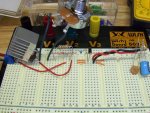100 microfarads would be aright. it may be bigger in size than lower value caps, thought. if you have a ceramic cap /10n-100n/ at hand, you could solder it in parallel with the electrolytic one, at best - directly across the prongs of the LD.
concerning safe operating conditions of ur LD, they are a combination of junction temperature and current. it will probably burn from close distance at only 120mA thru it, it is rated for 80mW CW at 130mA and working Tj of 75C, yet, keeping it cool below that, it will withstand, based on the general experience here, 250mA if not more. it would be interesting to at least have a vague idea about its expected lifetime versus current at a fixed temperature. in general-the harder you push it, the hotter it gets, the shorter it lives. running too much current thru it, though, even momentarily, will result in COD




